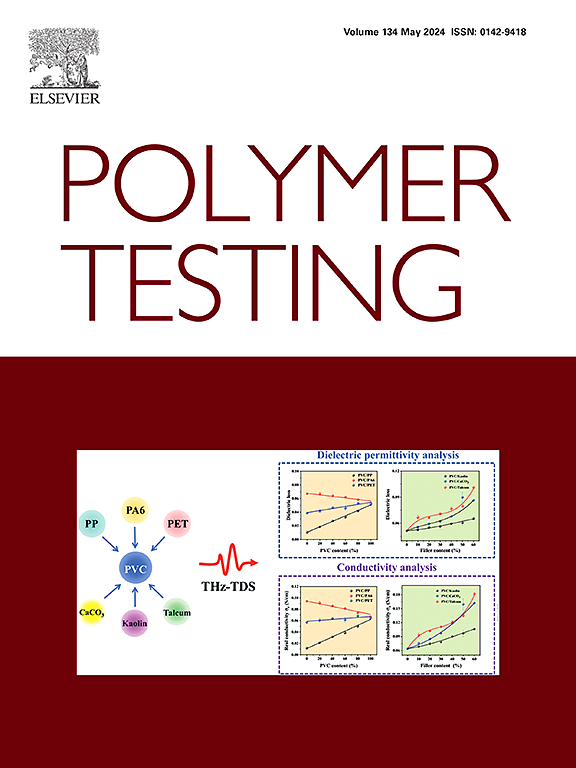Optimal formulation design of silicate-modified polymer based grouting material for reinforcing silty fine sand stratum
IF 5
2区 材料科学
Q1 MATERIALS SCIENCE, CHARACTERIZATION & TESTING
引用次数: 0
Abstract
To address the material requirements for grouting reinforcement in fine sand strata, a novel silicate-modified polymer two-component grouting material was designed. In this material, the traditional organic polyol component of the two-component polymer was replaced with an inorganic silicate (water glass) component, along with the addition of tertiary amine catalysts, organotin catalysts, water. The response surface methodology (RSM) was used to statistically predict the performance of the modified polymer grouting material. The effects of four parameters (two-component mass ratio, tertiary amine catalyst content, organotin catalyst content, and water content) and their interactions on response variables (gelation time, polymer solids strength, cemented body strength) were investigated. Based on a comprehensive consideration of various performance requirements for grouting materials in loose fine sand strata, multi-objective optimization was employed to determine the optimal formulation of the modified polymer grouting material (A/B ratio of 0.85, tertiary amine catalyst at 2.48 %, organotin catalyst at 0.63 %, and water at 1.87 %). A series of experimental tests were conducted to evaluate the material properties of the optimal formulation, and its mechanical performance and microstructural characteristics were compared with those of traditional polymer grouting materials to verify the proposed formation mechanism of the modified polymer. The results demonstrated that the proposed design method effectively determines the optimal grouting material formulation. The optimized modified polymer grouting material exhibited excellent comprehensive performance. Finally, the optimized modified polymer grouting material was applied in a pavement repair project on a section of a highway. After grouting, the structural layer's uniform integrity was significantly restored, the damaged areas were effectively repaired, the modified polymer slurry showed good diffusion, and the repair effect was satisfactory, meeting the engineering requirements for grouting in loose fine sand strata.
粉质细砂地层加固用硅酸盐改性聚合物基注浆材料的优化配方设计
针对细砂地层注浆加固对材料的要求,设计了一种新型硅酸盐改性聚合物双组份注浆材料。在这种材料中,传统的双组份聚合物的有机多元醇组分被无机硅酸盐(水玻璃)组分取代,同时加入叔胺催化剂、有机锡催化剂、水。采用响应面法(RSM)对改性高分子注浆材料的性能进行了统计预测。考察了4个参数(双组分质量比、叔胺催化剂含量、有机锡催化剂含量和水含量)及其相互作用对反应变量(胶凝时间、聚合物固体强度、胶结体强度)的影响。在综合考虑松散细砂地层注浆材料各种性能要求的基础上,采用多目标优化方法确定了改性高分子注浆材料的最佳配方(a /B比0.85,叔胺催化剂用量2.48%,有机锡催化剂用量0.63%,水用量1.87%)。通过一系列试验对优化配方的材料性能进行了评价,并将其力学性能和微观结构特征与传统聚合物注浆材料进行了比较,验证了所提出的改性聚合物的形成机理。结果表明,所提出的设计方法有效地确定了最优注浆材料配方。优化后的改性高分子注浆材料综合性能优异。最后,将优化后的改性高分子注浆材料应用于某高速公路某路段的路面修复工程。注浆后,结构层的均匀完整性得到明显恢复,损坏区域得到有效修复,改性聚合物浆具有良好的扩散,修复效果满意,满足了松散细砂地层注浆的工程要求。
本文章由计算机程序翻译,如有差异,请以英文原文为准。
求助全文
约1分钟内获得全文
求助全文
来源期刊

Polymer Testing
工程技术-材料科学:表征与测试
CiteScore
10.70
自引率
5.90%
发文量
328
审稿时长
44 days
期刊介绍:
Polymer Testing focuses on the testing, analysis and characterization of polymer materials, including both synthetic and natural or biobased polymers. Novel testing methods and the testing of novel polymeric materials in bulk, solution and dispersion is covered. In addition, we welcome the submission of the testing of polymeric materials for a wide range of applications and industrial products as well as nanoscale characterization.
The scope includes but is not limited to the following main topics:
Novel testing methods and Chemical analysis
• mechanical, thermal, electrical, chemical, imaging, spectroscopy, scattering and rheology
Physical properties and behaviour of novel polymer systems
• nanoscale properties, morphology, transport properties
Degradation and recycling of polymeric materials when combined with novel testing or characterization methods
• degradation, biodegradation, ageing and fire retardancy
Modelling and Simulation work will be only considered when it is linked to new or previously published experimental results.
 求助内容:
求助内容: 应助结果提醒方式:
应助结果提醒方式:


